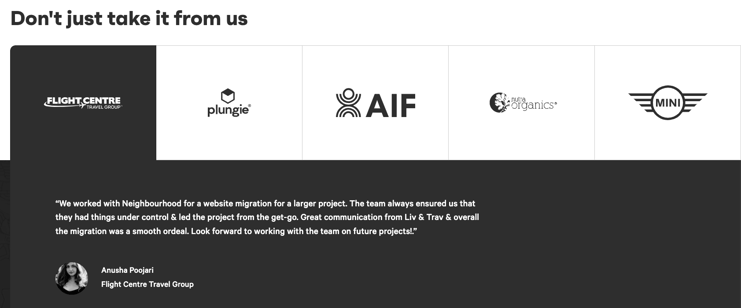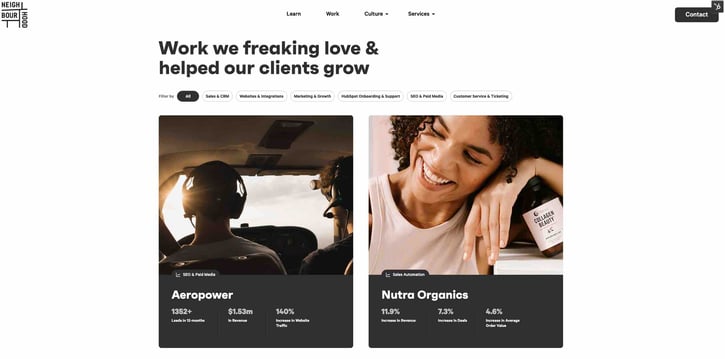When it comes to promoting your business, there is no tool more effective than a well-written case study. Case studies offer potential customers a detailed look at how your company has helped others achieve their goals and provide valuable insights into the inner workings of your business.
However, writing a case study can be a daunting task. Where do you start? What information should you include? How can you make sure your case study is engaging and informative?
Never fear! We've put together a step-by-step guide to help you write a case study that will showcase your company's work in the best possible light.
First, let's discuss what a case study is.
What is a Case Study?
A case study is a review of something that happened. Typically, they are built to showcase specific results or solutions and to provide a kind of behind-the-scenes look into how those results or solutions were achieved.
Sounds kind of vague, right? Well, case studies can vary depending on the industry. Let's break down a few.
Marketing Case Studies
A marketing case study is basically a story that businesses tell to show off how they solved a marketing problem. It's like a ''before and after'' photo, but with way more detail. Businesses use case studies to explain what kinds of strategies they used, what worked well, and what could have been better. An effective case study example is when companies will include "social proof" like quotes or testimonials from happy customers. In short, a marketing case study is a great way to learn about a company's successes (and failures) without having to go through the entire trial-and-error process yourself.
Business Case Studies
A business case study is often a story of how your company solved a problem for a particular client. By reading the case study, your potential customers will be able to see how you helped someone else achieve their goals, and they'll be able to apply those same lessons to their own business. The best case studies are usually ones that are highly specific and relatable. And just like any good story, they should have a beginning, middle, and end. In the beginning, you'll want to set the scene and introduce the characters (i.e., your company and the client). In the middle, you'll get into the nitty-gritty of how you solved the problem. And in the end, you'll tie everything up with a neat little bow by explaining the results. By following this simple formula, you can write a business case study that will engage and inspire your prospective customers.
Medical Case Studies
A medical case study is an in-depth analysis of a person's medical history and current condition. Doctors use case studies to discover new ways to treat diseases and gain insight into how the human body works. In a typical case study, a doctor will track a patient's progress over time, observing all the attempted treatments and the patient's response to them.
This can give doctors valuable information about the best way to treat a particular condition. Additionally, by studying individual cases, doctors can learn about rare diseases and find new cures.
"Okay, cool," you might be saying, "but which are we talking about?"
For our purposes, we'll be discussing marketing and business case studies. So, stop sweating–no need for medical study reports or medical licenses to keep reading this guide.
The Benefits of Case Studies
The main benefit of a business or marketing case study is to tell potential new clients or customers, "Hey, we know what we're doing. See–we've done it before, we've established client objectives and helped deliver our client great results!"
Case studies make great pieces of content to add to your sales enablement tools.
Some other benefits of creating a fantastic case study include:
- Helping companies see their impact better
- Providing breadcrumbs for future problem solving
- Showcasing the different industries (or clients) your business has had success with
- Helping provide content for social, websites, and blogs
- Providing your salespeople with something to show off
Where and When Are Case Studies Used?
A case study has multiple uses. Some case studies are considered evergreen, while others might only be relevant for a period of time. This flexibility is one of the great things about case studies.
Here are a few examples of where and when to use case studies.
On a Company Website
Most often, businesses will develop case studies and share them on their website so that future customers can find them. Typically, these are long-term case studies that are just as relevant today as when they were posted. When a company shares its site, they hope potential clients find them and see how effective its business can be for a partnership.
In Sales Enablement Tools
Every business has a product or service to sell. Case studies are excellent additions to sales enablement tools and provide your salespeople with qualitative and quantitative evidence that your solutions work. It’s that kind of proof that could tilt the scales in your favor when trying to gain new clients or grow your business.
In Blogs and Articles
Case studies make great content for blog posts and articles. In fact, putting a case study in longer-form content (most case studies are only a page or two long) allows the company to expound on the information further, providing an even deeper insight to those who find it. This type of content (blogs and articles) can be shared on their owned channels or across other online publications.
On Social Media
Case studies can also be posted on your social media channels. Typically, these posts are shorter and use more casual language but provide the viewer with information and a call to action to learn more.
Short-Term VS Long-Term Case Studies
As technology changes or new processes and tools make business cases obsolete, companies should consider whether their case studies are still relevant or not. A short-term example might be a case study about a one-time event or utilising a piece of software or platform no longer viable.
Long-term case studies are those that are relevant at any time. Though, it's likely a good idea to update your case studies from time to time to best reflect your company's capabilities or avoid incorrectly selling yourself.
How Often Should Case Studies Be Updated?
If unsure of how long a case study should live on your website, a good rule of thumb is at least a couple of years. Companies should either update the current case study to reflect the times better or replace it with more recent work that better articulates the company's objectives and capabilities.
6 Steps for Creating a Compelling Case Study
Alright, all this talk about case studies, and we still haven't shown you how to do one. Shame on us! Let's explore what makes an impactful case study and how you can create some for your business.
1. Decide what you want to achieve with your case study
First and foremost, you must decide the objective of your case study. Perhaps now you're thinking, "Um, to showcase how great we are, duh!" Well, yes...but what's the purpose of your greatness? What areas are you great in? What kind of customers or clients are you attempting to gain?
Here are a few things you might want to show off in your case study:
- Your social media marketing skills
- Your ability to utilise specific tools
- Success as a credible source within a particular industry
- Client success or growth for current customers
- Unique capabilities that separate you from your competitors
- Growth in a specific area of your own business
And more. Once you have selected your objective, it's time to gather crucial information to attract your ideal customer.
2. Gather crucial information
You know what meal you're cooking, so now you just need to gather the ingredients. It's time to dig through your numbers and find the most jaw-dropping ones. Make sure they are numbers that will impress. Most people wouldn't blink at a single-digit increase in sales. But, a double or a triple-digit increase? That's worth bragging about!
Hopefully, you have the numbers yourself, but don't hesitate to reach out to clients for assistance. Chances are they want you to succeed, especially if you were able to help them reach new heights.
If you're doing a social media case study, you'll need social stats. Are you building a website case study? You'll need some Google or site analytics.
If it's more of a qualitative (no hard statistics to pull) case study, you'll need to gather some tangible information on the growth or improvements you were able to help your clients achieve. This is where quotes or testimonials can be a big help.
During this stage, just focus on the numbers or the facts. Next, we figure out what story we're going to tell.
3. Build your story
Numbers are always great, but do you know what people react to more? A good story. In fact, did you know that personal and compelling stories have been scientifically proven to engage more of the brain and help people remember things better?
It’s true! So, before you go spouting off number after number and percentages and fractions, remember that if those numbers aren’t part of a story, then you might as well be saying them to a wall.
What makes a good story? Memorable stories should have some of these elements:
- Drama
- Relatability
- Immersion
- Simplicity
- Meaning
- Familiarity
- Trust
And yes, a story needs a beginning, middle, and end–no matter how long or short.
Want an example?
Let’s say you’re writing a case study on how you helped Company A improve engagement on their social channels.
First, you might start with a problem:
Company A was posting regularly, but their audience didn’t seem to care. (Drama)
Next, you might mention an insight your team discovered that could help.
Our marketing team found that Company A wasn’t responding to their audience’s questions but instead just publishing posts that mentioned their own achievements. (Immersion and Familiarity)
Thirdly, it’s time to (briefly) explain the solution.
So our team went to work creating a list of topics that Company A’s audience cared about, based on the questions they were asking. (Relatability and Simplicity)
Finally, you bring it home with the results.
After six months, engagement numbers grew by 150%, and Company A received 3X as many leads through social media year-over-year. (Meaning and Trust)
Boom = Satisfied Customer! You’ve got yourself a bonafide story-driven case study.
Want to see some real-life examples? Check out the case studies on our site.
4. Build a case study template
Not all case studies are the same–and they shouldn’t be. Variety is the spice of life, after all. But, building out a few templates you can use over and over again will go a long way toward helping you and your team create more quickly and easily in the future.
Fortunately, this is really simple.
Here are a few formulas to follow:
Problem - Insight - Solution - Results
This template is similar to the one we did above. You start with a problem, preferably one that many companies have. Then, you provide the insight your team was able to uncover. This shows that you do your research and know the industry your client is in. The solution should be put simply–no one needs all the nitty-gritty details. And finally, the results that hopefully blow your potential new customer’s mind.
Testimonials & Interviews
Sometimes, explaining your value is a challenge. And talking about yourself isn’t nearly as strong as having someone else talk about you. Perform actual interviews with your clients and record the exact things they say you did for them and how you did it. Use those same words to build out your case study. These can be especially strong if the company you interviewed has an excellent reputation in their industry.
Benefit-Focused
Remember, at the end of the day, all someone really wants to know is what’s in it for them (WIIFM). If your work provided multiple benefits or saw results across the board, then build an in depth case study that focuses on all the benefits you and your team provided. Briefly mention the problem, maybe even the solution, but get to the benefits and highlight the heck out of those.
The Transformation (Before & After)
Everyone loves a good transformation story. Showcase how you took Company X from point A to point Z without breaking a sweat. The before state should seem desolate, impossible to get out of, and the world (and their business) is coming to an end (okay, maybe not that dramatic, but as close as you can get!). Then, the after state should show the company you helped slowly walking away from a massive explosion, saying some live-action superhero movie line like “Yippee Ki Yay mother…” (you know the rest).
The goal of the transformation should be to showcase how you took your clients to brand new heights even they didn’t think they could achieve.
There is no one-size-fits-all case study template. Instead, pick one or a few and start building it out.
5. Write the case study
You’ve got your numbers. You’ve built your story. You have decided on a template. Now, it’s time to write it. Don’t fret if you aren’t 100% positive about the previous things. Let’s get it down in a document and see how it goes. Words can always be changed or written better later on.
Regardless of what you write and how you tell the case study story, the most crucial part is that it is impactful and impressive. So, once you’re finished, send it to your team and get their thoughts on it. If some of them worked on that particular project, they might even be able to provide pieces of information that you forgot or didn’t know about.
Take a few rounds of edits and get your case study in a perfect spot. Case studies could live on your website for years and be a key sales enablement tool for your business–so make sure you’re happy with it.
6. Add visuals to make it more interesting
Text alone can be boring. Add some cool graphics, images, or interactive elements to your case studies when you can. Hopefully, someone on your team can help, but if not, there are plenty of companies with services out there that can–like us!
7. Publish and promote your case study
You’ve worked hard on this case study, so let’s show it off! Put it on your website, share it with your salespeople, post it to social media and maybe even write a blog about it. You did a bang-up job showcasing your previous bang-up job, and you shouldn’t shy away from sharing that.
We’re proud of you.
Hopefully, this guide has helped you better understand the purpose of case studies and how you can build some for yourself and your business to attract your ideal customer. They truly can make a massive difference for your business or organization and do a lot of heavy lifting that a phone call or email just can’t.
If you find yourself still wondering what to do or how to showcase how awesome your business is, then contact us. We specialise in working with marketing & sales systems to attract, convert and serve. We build systems & content that people are stoked to engage with.



